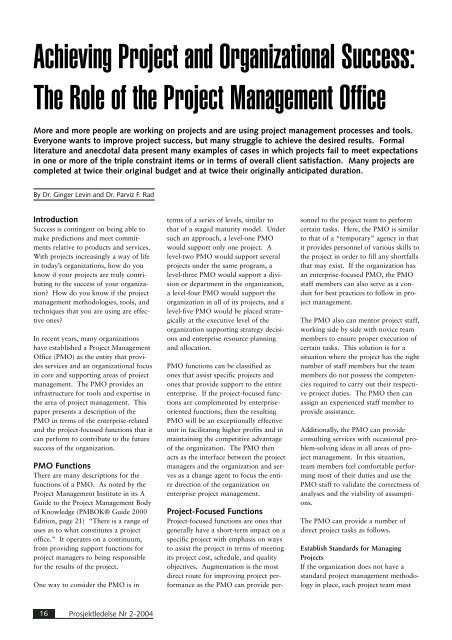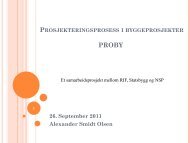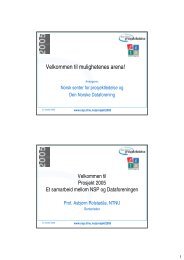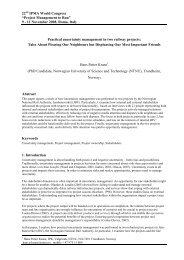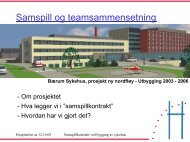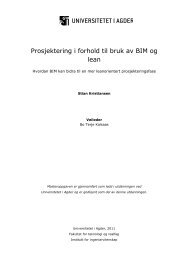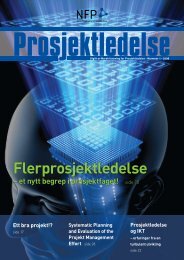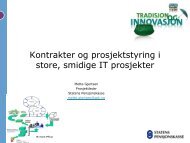Achieving Project and Organizational Success:The Role of the Project Management OfficeMore and more people are working on projects and are using project management processes and tools.Everyone wants to improve project success, but many struggle to achieve the desired results. Formalliterature and anecdotal data present many examples of cases in which projects fail to meet expectationsin one or more of the triple constraint items or in terms of overall client satisfaction. Many projects arecompleted at twice their original budget and at twice their originally anticipated duration.By Dr. Ginger Levin and Dr. Parviz F. RadIntroductionSuccess is contingent on being able tomake predictions and meet commitmentsrelative to products and services.With projects increasingly a way of lifein today’s organizations, how do youknow if your projects are truly contributingto the success of your organization?How do you know if the projectmanagement methodologies, tools, andtechniques that you are using are effectiveones?In recent years, many organizationshave established a Project ManagementOffice (PMO) as the entity that providesservices and an organizational focusin core and supporting areas of projectmanagement. The PMO provides aninfrastructure <strong>for</strong> tools and expertise inthe area of project management. Thispaper presents a description of thePMO in terms of the enterprise-relatedand the project-focused functions that itcan per<strong>for</strong>m to contribute to the futuresuccess of the organization.PMO FunctionsThere are many descriptions <strong>for</strong> thefunctions of a PMO. As noted by theProject Management Institute in its AGuide to the Project Management Bodyof Knowledge (PMBOK® Guide 2000Edition, page 21) “There is a range ofuses as to what constitutes a projectoffice.” It operates on a continuum,from providing support functions <strong>for</strong>project managers to being responsible<strong>for</strong> the results of the project.One way to consider the PMO is interms of a series of levels, similar tothat of a staged maturity model. Undersuch an approach, a level-one PMOwould support only one project. Alevel-two PMO would support severalprojects under the same program, alevel-three PMO would support a divisionor department in the organization,a level-four PMO would support theorganization in all of its projects, and alevel-five PMO would be placed strategicallyat the executive level of theorganization supporting strategy decisionsand enterprise resource planningand allocation.PMO functions can be classified asones that assist specific projects andones that provide support to the entireenterprise. If the project-focused functionsare complemented by enterpriseorientedfunctions, then the resultingPMO will be an exceptionally effectiveunit in facilitating higher profits and inmaintaining the competitive advantageof the organization. The PMO thenacts as the interface between the projectmanagers and the organization and servesas a change agent to focus the entiredirection of the organization onenterprise project management.Project-Focused FunctionsProject-focused functions are ones thatgenerally have a short-term impact on aspecific project with emphasis on waysto assist the project in terms of meetingits project cost, schedule, and qualityobjectives. Augmentation is the mostdirect route <strong>for</strong> improving project per<strong>for</strong>manceas the PMO can provide per-sonnel to the project team to per<strong>for</strong>mcertain tasks. Here, the PMO is similarto that of a “temporary” agency in thatit provides personnel of various skills tothe project in order to fill any shortfallsthat may exist. If the organization hasan enterprise-focused PMO, the PMOstaff members can also serve as a conduit<strong>for</strong> best practices to follow in projectmanagement.The PMO also can mentor project staff,working side by side with novice teammembers to ensure proper execution ofcertain tasks. This solution is <strong>for</strong> asituation where the project has the rightnumber of staff members but the teammembers do not possess the competenciesrequired to carry out their respectiveproject duties. The PMO then canassign an experienced staff member toprovide assistance.Additionally, the PMO can provideconsulting services with occasional problem-solvingideas in all areas of projectmanagement. In this situation,team members feel com<strong>for</strong>table per<strong>for</strong>mingmost of their duties and use thePMO staff to validate the correctness ofanalyses and the viability of assumptions.The PMO can provide a number ofdirect project tasks as follows.Establish Standards <strong>for</strong> ManagingProjectsIf the organization does not have astandard project management methodologyin place, each project team must16Prosjektledelse <strong>Nr</strong> 2-<strong>2004</strong>
determine the procedures it will followand the tools and techniques to use.The PMO can provide assistance bysetting up basic standards to be followedon each project. This processwould consist of a set of core tasks tobe per<strong>for</strong>med on each project withstandard templates <strong>for</strong> items such asthe project plan, work breakdownstructure, resource breakdown structure,and the activity list. When the organizationthen has a consistent approachto project management, each projectcan proceed more effectively and efficiently.Project professionals can transitioneasily to new projects, as there willbe a common frame of reference <strong>for</strong>project management in the organization.Standardize ReportingReporting on projects is a mandatoryactivity in most organizations. If theorganization does not have a PMO,however, each project has to establishits own system. Reports tend to be preparedin response to special requests.At times, the project team may feel thatit is spending undue amounts of timeresponding to requests <strong>for</strong> in<strong>for</strong>mationby stakeholders. The PMO can provideassistance by setting up standard report<strong>for</strong>ms <strong>for</strong> use on each project and byspecifying internal reporting requirements.It further can establish an internaldistribution system <strong>for</strong> reporting.Select, Operate, and Support ProjectManagement SoftwareThe increased visibility of projectmanagement as a competitive necessity<strong>for</strong> organizations has led to a widevariety of software tools that can beused. Selecting the right tool or set oftools to use is important. The toolsrange from those <strong>for</strong> enterprise projectmanagement to a specific application,such as scheduling, estimating, or configurationmanagement. The PMO staffcan take responsibility <strong>for</strong> softwareselection, operation, and maintenance.Through standard tools, it then is easierto analyze data on projects, minimizeduplicate data entry, and facilitatein<strong>for</strong>mation exchange. The PMO staffcan be trained in use of the softwareand then can provide support to eachproject team in terms of installing thesoftware, populating the database, keepingthe system up to date, preparingreports, and distributing them to stakeholders.Project Start-Up AssistanceIn many organizations, the projectmanager is assigned at the beginning ofthe planning phase of the project.Often, when the project manager isassigned, the team members have notyet been identified. Until the project isfully staffed, the PMO can provideresources to support the project on aninterim basis. These staff members candesign the in<strong>for</strong>mation systems, definethe control systems, set up the projectworkbook, establish a “war” room orteam room, prepare documents, andprovide overall staff support.Further, the PMO staff can provideassistance in the preparation of the projectcharter and the scope statement.The PMO can provide standard <strong>for</strong>mats<strong>for</strong> these critical documents andcan assist in their development.Once the team has been established, akick-off meeting is recommended.During the kick-off meeting, teammembers can get to know one another,establish working relationships, and setspecific team goals and operating proceduresthrough the preparation of ateam charter. The PMO can facilitatethe kick-off meeting to create a conductiveatmosphere in which open communicationis fostered from the beginningon the project.Risk Management SupportManaging risk is a key component ofproject success and is an ongoing activityon each project. The PMO can preparea template <strong>for</strong> a risk managementplan that each project can use. Thistemplate can help the team determinehow to handle risk management activitiesand ways to ensure that risk hasvisibility at the project and organizationallevels. It can assist the team indetermining specific threshold criteria<strong>for</strong> risks. The PMO can identify, categorize,and analyze specific risks basedon previous work in support of otherprojects in the organization. Checklistsand tables can promote consistency anduni<strong>for</strong>mity. Once risks have been identifiedand analyzed, the PMO staff cansupport the team in tracking and monitoringthem. Risk audits and reviewscan be conducted. With PMO involvement,a repository or database can beset up on risk management as part ofan overall knowledge management systemin the organization.Project Monitoring and ControlThe PMO additionally can support theteam in project monitoring and control.It can set up and maintain a projectvisibility room, team room, in<strong>for</strong>mationroom, or “war” room to enable theteam to share ideas and in<strong>for</strong>mation.Up-to-date in<strong>for</strong>mation can be maintained.Additionally, since many projectteams lack the luxury of a team memberto serve as a documentation manageror configuration manager, the PMOcan support the project team by maintainingproject documentation or theproject workbook. Effective projectdocumentation supports the projectmanagement in<strong>for</strong>mation system.Then, as the project moves into the executingphase, the PMO can assist in theareas of tracking and managing changesto project requirements by establishinga standard change control system andan integrated change control process.With PMO involvement, a change onone project that may affect anotherproject in terms of resources, schedule,or quality issues can be identified andcoordinated.Administrative assistance can be providedto help the team monitor and trackper<strong>for</strong>mance. The PMO staff can reviewobjectives against the plan and cansuggest needed changes and preventiveaction be<strong>for</strong>e serious problems develop.It can promote issue resolution by establishingand maintaining an issue trackingsystem.Further, the PMO can assist in establishinga standard <strong>for</strong>mat <strong>for</strong> project reviewsto assess the status and report theprogress of the project. It is importantto look at the project from a strategicperspective to determine whether theproject is meeting its objectives andshould continue to receive resources.The PMO staff can help project teamsprepare <strong>for</strong> these reviews and can facilitatethem so they are conducted in aneutral, objective way.➢Prosjektledelse <strong>Nr</strong> 2-<strong>2004</strong> 17


